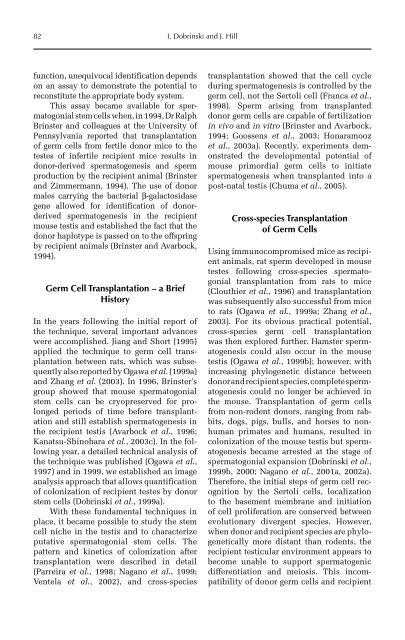Redesigning Animal Agriculture
Redesigning Animal Agriculture
Redesigning Animal Agriculture
You also want an ePaper? Increase the reach of your titles
YUMPU automatically turns print PDFs into web optimized ePapers that Google loves.
82 I. Dobrinski and J. Hill<br />
function, unequivocal identification depends<br />
on an assay to demonstrate the potential to<br />
reconstitute the appropriate body system.<br />
This assay became available for spermatogonial<br />
stem cells when, in 1994, Dr Ralph<br />
Brinster and colleagues at the University of<br />
Pennsylvania reported that transplantation<br />
of germ cells from fertile donor mice to the<br />
testes of infertile recipient mice results in<br />
donor-derived spermatogenesis and sperm<br />
production by the recipient animal (Brinster<br />
and Zimmermann, 1994). The use of donor<br />
males carrying the bacterial β-galactosidase<br />
gene allowed for identification of donorderived<br />
spermatogenesis in the recipient<br />
mouse testis and established the fact that the<br />
donor haplotype is passed on to the offspring<br />
by recipient animals (Brinster and Avarbock,<br />
1994).<br />
Germ Cell Transplantation – a Brief<br />
History<br />
In the years following the initial report of<br />
the technique, several important advances<br />
were accomplished. Jiang and Short (1995)<br />
applied the technique to germ cell transplantation<br />
between rats, which was subsequently<br />
also reported by Ogawa et al. (1999a)<br />
and Zhang et al. (2003). In 1996, Brinster’s<br />
group showed that mouse spermatogonial<br />
stem cells can be cryopreserved for prolonged<br />
periods of time before transplantation<br />
and still establish spermatogenesis in<br />
the recipient testis (Avarbock et al., 1996;<br />
Kanatsu-Shinohara et al., 2003c). In the following<br />
year, a detailed technical analysis of<br />
the technique was published (Ogawa et al.,<br />
1997) and in 1999, we established an image<br />
analysis approach that allows quantification<br />
of colonization of recipient testes by donor<br />
stem cells (Dobrinski et al., 1999a).<br />
With these fundamental techniques in<br />
place, it became possible to study the stem<br />
cell niche in the testis and to characterize<br />
putative spermatogonial stem cells. The<br />
pattern and kinetics of colonization after<br />
transplantation were described in detail<br />
(Parreira et al., 1998; Nagano et al., 1999;<br />
Ventela et al., 2002), and cross-species<br />
transplantation showed that the cell cycle<br />
during spermatogenesis is controlled by the<br />
germ cell, not the Sertoli cell (Franca et al.,<br />
1998). Sperm arising from transplanted<br />
donor germ cells are capable of fertilization<br />
in vivo and in vitro (Brinster and Avarbock,<br />
1994; Goossens et al., 2003; Honaramooz<br />
et al., 2003a). Recently, experiments demonstrated<br />
the developmental potential of<br />
mouse primordial germ cells to initiate<br />
spermatogenesis when transplanted into a<br />
post-natal testis (Chuma et al., 2005).<br />
Cross-species Transplantation<br />
of Germ Cells<br />
Using immunocompromised mice as recipient<br />
animals, rat sperm developed in mouse<br />
testes following cross-species spermatogonial<br />
transplantation from rats to mice<br />
(Clouthier et al., 1996) and transplant ation<br />
was subsequently also successful from mice<br />
to rats (Ogawa et al., 1999a; Zhang et al.,<br />
2003). For its obvious practical potential,<br />
cross-species germ cell transplantation<br />
was then explored further. Hamster spermatogenesis<br />
could also occur in the mouse<br />
testis (Ogawa et al., 1999b); however, with<br />
increasing phylogenetic distance between<br />
donor and recipient species, complete spermatogenesis<br />
could no longer be achieved in<br />
the mouse. Transplantation of germ cells<br />
from non-rodent donors, ranging from rabbits,<br />
dogs, pigs, bulls, and horses to nonhuman<br />
primates and humans, resulted in<br />
colonization of the mouse testis but spermatogenesis<br />
became arrested at the stage of<br />
spermatogonial expansion (Dobrinski et al.,<br />
1999b, 2000; Nagano et al., 2001a, 2002a).<br />
Therefore, the initial steps of germ cell recognition<br />
by the Sertoli cells, localization<br />
to the basement membrane and initiation<br />
of cell proliferation are conserved between<br />
evolutionary divergent species. However,<br />
when donor and recipient species are phylogenetically<br />
more distant than rodents, the<br />
recipient testicular environment appears to<br />
become unable to support spermatogenic<br />
differentiation and meiosis. This incompatibility<br />
of donor germ cells and recipient










